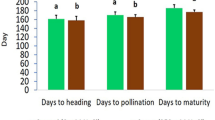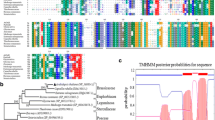Abstract
Key message
Autotetraploid Arabidopsis line esd and 4COL exhibit enhanced tolerance to Cu stress by enhancing activation of antioxidative defenses, altering expression of genes related to Cu transport, chelation, and ABA-responsive.
Abstract
Autopolyploidy is ubiquitous among angiosperms and often results in better adaptation to stress conditions. Although copper (Cu) is an essential trace element, excess amounts can inhibit plant growth and even result in death. Here, we report that autotetraploid Arabidopsis thaliana esd and 4COL exhibit higher tolerance to Cu stress. Under such conditions, tetraploid plants had lower Cu contents and significantly more biomass compared with diploid plants. When exposed to excess Cu for 24 h, levels of superoxide anions, hydrogen peroxide, and malondialdehyde were lower in tetraploids than in diploids. Moreover, activities of the antioxidant enzymes superoxide dismutase and peroxidase were stimulated and glutathione content was maintained at a relative higher level in the tetraploids. The expression of genes related to Cu transport and chelation was altered in autotetraploid Arabidopsis under Cu stress, and several key genes involved in the response to abscisic acid (ABA) were significantly up-regulated. Our results indicate that tetraploid Arabidopsis esd and 4COL acquire improved tolerance to Cu stress through enhanced activation of antioxidative defense mechanisms, altered expression of genes related to Cu transport and chelation, and positive regulation of expression for ABA-responsive genes.








Similar content being viewed by others
References
Allario T, Brumos J, Colmenero-Flores JM, Iglesias DJ, Pina JA, Navarro L, Talon M, Ollitrault P, Morillon R (2013) Tetraploid Rangpur lime rootstock increases drought tolerance via enhanced constitutive root abscisic acid production. Plant Cell Environ 36:856–868
Andrés-Colás N, Sancenón V, Rodríguez-Navarro S, Mayo S, Thiele DJ, Ecker JR, Puig S, Peñarrubia L (2006) The Arabidopsis heavy metal P-type ATPase HMA5 interacts with metallochaperones and functions in copper detoxification of roots. Plant J 45:225–236
Attallah CV, Welchen E, Gonzalez DH (2007) The promoters of Arabidopsis thaliana genes AtCOX17-1 and -2, encoding a copper chaperone involved in cytochrome c oxidase biogenesis, are preferentially active in roots and anthers and induced by biotic and abiotic stress. Physiol Plantarum 129:123–134
Baryla A, Laborde C, Montillet JL, Triantaphylides C, Chagvardieff P (2000) Evaluation of lipid peroxidation as a toxicity bioassay for plants exposed to copper. Environ Pollut 109:131–135
Bevan M, Walsh S (2005) The Arabidopsis genome: a foundation for plant research. Genome Res 15:1632–1642
Blanc G, Wolfe KH (2004) Widespread paleopolyploidy in model plant species inferred from age distributions of duplicate genes. Plant Cell 16:1667–1678
Burkhead JL, Reynolds KA, Abdel-Ghany SE, Cohu CM, Pilon M (2009) Copper homeostasis. New Phytol 182:799–816
Carrio-Segui A, Romero P, Sanz A, Penarrubia L (2016) Interaction between ABA signaling and copper homeostasis in Arabidopsis thaliana. Plant Cell Physiol 57:1568–1582
Chao D, Dilkes B, Luo H, Douglas A, Yakubova E, Lahner B, Salt D (2013) Polyploids exhibit higher potassium uptake and salinity tolerance in Arabidopsis. Science 341:658–659
Chen ZJ (2010) Molecular mechanisms of polyploidy and hybrid vigor. Trends Plant Sci 15:57–71
Chen ZJ, Wang J, Tian L, Lee HS, Wang JJ, Chen M, Lee JJ, Josefsson C, Madlung A, Watson B (2004) The development of an Arabidopsis model system for genome-wide analysis of polyploidy effects. Biol J Linn Soc Lond 82:689–700
Clemens S (2001) Molecular mechanisms of plant metal tolerance and homeostasis. Planta 212:475–486
Cui Y, Xu G, Wang M, Yu Y, Li M, da Rocha PSCF, Xia X (2013) Expression of OsMSR3 in Arabidopsis enhances tolerance to cadmium stress. Plant Cell Tiss Org Cult 113:331–340
Cuypers A, Smeets K, Ruytinx J, Opdenakker K, Keunen E, Remans T, Horemans N, Vanhoudt N, van Sanden S, van Belleghem F, Guisez Y, Colpaert J, Vangronsveld J (2011) The cellular redox state as a modulator in cadmium and copper responses in Arabidopsis thaliana seedlings. J Plant Physiol 168:309–316
Deng B, Du W, Liu C, Sun W, Tian S, Dong H (2011) Antioxidant response to drought, cold and nutrient stress in two ploidy levels of tobacco plants: low resource requirement confers polytolerance in polyploids? Plant Growth Regul 66:37–47
Drążkiewicz M, Skórzyńska-Polit E, Krupa Z (2004) Copper-induced oxidative stress and antioxidant defence in Arabidopsis thaliana. Biometals 17:379–387
Du J, Yang J-L, Li C-H (2012) Advances in metallothionein studies in forest trees. Plant Omics 5(1):46–51
Foyer CH, Noctor G (2011) Ascorbate and glutathione: the heart of the redox hub. Plant Physiol 155:2–18
Fu L, Chen C, Wang B, Zhou X, Li S, Guo P, Shen Z, Wang G, Chen Y (2015) Differences in copper absorption and accumulation between copper-exclusion and copper-enrichment plants: a comparison of structure and physiological responses. PLoS One 10:e0133424
Garcia L, Welchen E, Gey U, Arce AL, Steinebrunner I, Gonzalez DH (2016) The cytochrome c oxidase biogenesis factor AtCOX17 modulates stress responses in Arabidopsis. Plant, Cell Environ 39(3):628
Guo WJ, Bundithya W, Goldsbrough PB (2003) Characterization of the Arabidopsis metallothionein gene family: tissue-specific expression and induction during senescence and in response to copper. New Phytol 159:369–381
Huang C, He W, Guo J, Chang X, Su P, Zhang L (2005) Increased sensitivity to salt stress in an ascorbate-deficient Arabidopsis mutant. J Exp Bot 56:3041–3049
Jaleel CA, Riadh K, Gopi R, Manivannan P, Inès J, Al-Juburi HJ, Chang-Xing Z, Hong-Bo S, Panneerselvam R (2009) Antioxidant defense responses: physiological plasticity in higher plants under abiotic constraints. Acta Physiol Plant 31:427–436
Kampfenkel K, Kushnir S, Babiychuk E, Inzé D, Van Montagu M (1995) Molecular characterization of a putative Arabidopsis thaliana copper transporter and its yeast homologue. J Biol Chem 270:28479–28486
Kasajima I, Yoshizumi T, Ichikawa T, Matsui M, Fujiwara T (2010) Possible involvement of ploidy in tolerance to boron deficiency in Arabidopsis thaliana. Plant Biotechnol 27:435–445
Kobayashi Y, Kuroda K, Kimura K, Southron-Francis JL, Furuzawa A, Kimura K, Iuchi S, Kobayashi M, Taylor GJ, Koyama H (2008) Amino acid polymorphisms in strictly conserved domains of a P-type ATPase HMA5 are involved in the mechanism of copper tolerance variation in Arabidopsis. Plant Physiol 148:969–980
Li L, Yi H (2012) Effect of sulfur dioxide on ROS production, gene expression and antioxidant enzyme activity in Arabidopsis plants. Plant Physiol Biochem 58:46–53
Li X, Yu E, Fan C, Zhang C, Fu T, Zhou Y (2012) Developmental, cytological and transcriptional analysis of autotetraploid Arabidopsis. Planta 236:579–596
Maksymiec W, Krupa Z (2006) The effects of short-term exposition to Cd, excess Cu ions and jasmonate on oxidative stress appearing in Arabidopsis thaliana. Environ Exp Bot 57:187–194
Meng H, Jiang S, Hua S, Lin X, Li Y, Guo W, Jiang L (2011) Comparison between a tetraploid turnip and its diploid progenitor (Brassica rapa L.): the adaptation to salinity stress. Agr Sci China 10:363–375
Miller M, Zhang C, Chen ZJ (2012) Ploidy and hybridity effects on growth vigor and gene expression in Arabidopsis thaliana hybrids and their parents. G3 (Bethesda) 2:505–513
Nagalakshmi N, Prasad MNV (2001) Responses of glutathione cycle enzymes and glutathione metabolism to copper stress in Scenedesmus bijugatus. Plant Sci 160:291–299
Ng DWK, Zhang C, Miller M, Shen Z, Briggs SP, Chen ZJ (2011) Proteomic divergence in Arabidopsis autopolyploids and allopolyploids and their progenitors. Heredity 108:419–430
Niwa Y, Sasaki Y (2003) Plant self-defense mechanisms against oxidative injury and protection of the forest by planting trees of triploids and tetraploids. Ecotox Environ Safe 55:70–81
Osborn TC, Pires JC, Birchler JA, Auger DL, Chen ZJ, Lee H-S, Comai L, Madlung A, Doerge RW, Colot V (2003) Understanding mechanisms of novel gene expression in polyploids. Trends Genet 19:141–147
Polle A, Schützendübel A (2003) Heavy metal signalling in plants: linking cellular and organismic responses. In: Hirt H, Shinozaki K (eds) Plant responses to abiotic stress. Springer, Berlin, Heidelberg, pp 187–215
Pozo JC, Ramirez-Parra E (2014) Deciphering the molecular bases for drought tolerance in Arabidopsis autotetraploids. Plant, Cell Environ 37:2722–2737
Pozo JC, Ramirez-Parra E (2015) Whole genome duplications in plants: an overview from Arabidopsis. J Exp Bot 66:6991–7003
Puig S, Andrés-Colás N, García-Molina A, Peñarrubia L (2007) Copper and iron homeostasis in Arabidopsis: responses to metal deficiencies, interactions and biotechnological applications. Plant, Cell Environ 30:271–290
Ramsey J, Schemske DW (2002) Neopolyploidy in flowering plants. Annu Rev Ecol Syst 33:589–639
Ren C, Xu GY, Li MJ, Cui YC, Wang ML, Xia XJ (2015) Zinc tolerance and its mechanism in autotetraploid Arabidopsis thaliana. Plant Physiol J 51:189–196
Romero-Puertas MC, Rodríguez-Serrano M, Corpas FJ, Gomez Md, Del Rio LA, Sandalio LM (2004) Cadmium-induced subcellular accumulation of O ·−2 and H2O2 in pea leaves. Plant, Cell Environ 27:1122–1134
Sandalio LM, Dalurzo HC, Gomez M, Romero-Puertas MC, Del Rio LA (2001) Cadmium-induced changes in the growth and oxidative metabolism of pea plants. J Exp Bot 52:2115–2126
Sevanian A, Ursini F (2000) Lipid peroxidation in membranes and low-density lipoproteins: similarities and differences. Free Radic Bio Med 29:306–311
Tan FQ, Tu H, Liang WJ, Long JM, Wu XM, Zhang HY, Guo WW (2015) Comparative metabolic and transcriptional analysis of a doubled diploid and its diploid citrus rootstock (C. junos cv. Ziyang xiangcheng) suggests its potential value for stress resistance improvement. BMC Plant Biol 15:89
Tavan M, Mirjalili MH, Karimzadeh G (2015) In vitro polyploidy induction: changes in morphological, anatomical and phytochemical characteristics of Thymus persicus (Lamiaceae). Plant Cell Tiss Org Cult 122:573–583
Thounaojam TC, Panda P, Mazumdar P, Kumar D, Sharma GD, Sahoo L, Sanjib P (2012) Excess copper induced oxidative stress and response of antioxidants in rice. Plant Physiol Bioch 53:33–39
Tsukaya H (2013) Does ploidy level directly control cell size? Counterevidence from Arabidopsis genetics. PLoS One 8:e83729
Xu M, Chen R, Rocha P, Li L, Wang M, Xu G, Xia X (2008) Expression and cloning of a novel stress responsive gene (OsMsr1) in rice. Acta Agron Sin 10:1712–1718
Xu GY, Rocha PS, Wang ML, Xu ML, Cui YC, Li LY, Zhu YX, Xia X (2011) A novel rice calmodulin-like gene, OsMSR2, enhances drought and salt tolerance and increases ABA sensitivity in Arabidopsis. Planta 234:47–59
Yang PM, Huang QC, Qin GY, Zhao SP, Zhou JG (2014) Different drought-stress responses in photosynthesis and reactive oxygen metabolism between autotetraploid and diploid rice. Photosynthetica 52:193–202
Ye N, Li H, Zhu G, Liu YL, Liu R, Xu W, Jing Y, Peng X, Jianhua Z (2014) Copper suppresses abscisic acid catabolism and catalase activity and inhibits seed germination of rice. Plant Cell Physiol 55:2008–2016
Yruela I (2005) Copper in plants. Braz J Plant Physiol 17:145–156
Yruela I (2009) Copper in plants: acquisition, transport and interactions. Funct Plant Biol 36:409–430
Zengin FK, Kirbag S (2007) Effects of copper on chlorophyll, proline, protein and abscisic acid level of sunflower (Helianthus annuus L.) seedlings. J Environ Biol 28:561
Zhang XY, Hu CG, Yao JL (2010) Tetraploidization of diploid Dioscorea results in activation of the antioxidant defense system and increased heat tolerance. J Plant Physiol 167:88–94
Zhou J, Goldsbrough P (1994) Functional homologs of funga1 metallothionein genes from Arabidopsis. Plant Cell 6:875–884
Zhou Y, Harrison DE, Love-Myers K, Chen Y, Grider A, Wickwire K, Burgess JR, Stochelski MA, Pazdro R (2014) Genetic analysis of tissue glutathione concentrations and redox balance. Free Radic Biol Med 71:157–164
Acknowledgements
This work was financially supported by the National Natural Science Foundation of China (Grant Nos. 31401314, 31501393 and 31671671), Hunan Province Natural Science Foundation of China (2016JJ4088) and Youth Innovation Team Project of ISA, CAS (2017QNCXTD_GTD).
Author information
Authors and Affiliations
Corresponding author
Ethics declarations
Conflict of interest
The authors declare that they have no conflict of interest.
Additional information
Communicated by Dr. Leena Tripathi.
Electronic supplementary material
Below is the link to the electronic supplementary material.
Rights and permissions
About this article
Cite this article
Li, M., Xu, G., Xia, X. et al. Deciphering the physiological and molecular mechanisms for copper tolerance in autotetraploid Arabidopsis. Plant Cell Rep 36, 1585–1597 (2017). https://doi.org/10.1007/s00299-017-2176-2
Received:
Accepted:
Published:
Issue Date:
DOI: https://doi.org/10.1007/s00299-017-2176-2




